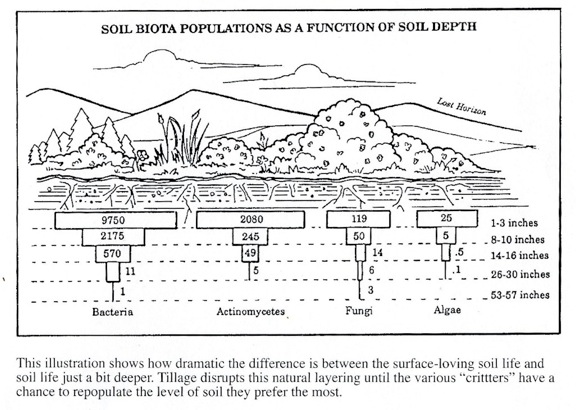The Importance of Soil Biota and Proper Moisture

Good Bacteria is at the top
If we were to shrink ourselves and a submarine down to microbe size, as in the 1970s movie Fantastic Voyage, and putter around counting the myriad of flora found in the soil, we'd generate the chart found here. In this drawing, the top 3 inches of soil has nearly 4.5 times more bacteria, almost 8.5 times more actinomycetes (tiny aerobic organisms that help decompose dead plant tissue), more than twice as many fungi and five times the algae of soil found 8 to 10 inches deep. These aerobic organisms are responsible for decomposing organic matter and liberating mineralized (unavailable) nutrients into a soluble form that the plant can absorb.
Moisture is essential for nutrient transport
In the soil's upper layers, moisture is essential for the transport of nutrients from the humus colloids and soil particles to the root hairs. (Humus, a complex compound that is the end result of decomposition of organic matter, holds soil particles together for good drainage while retaining moisture and nutrients.) This doesn't mean your garden soil should be mucky wet. The ideal soil is moist but still crumbles easily when you handle it--you certainly couldn't squeeze water out of it. A soil that is moist enough to promote good plant growth is also ideal for most soil bacteria. In a wet soil, the pore space (the natural drainage and "air ducts" of a well-structured soil) becomes saturated and anaerobic, and some of the root hairs and soil life die. This can happen during long rainstorms or lengthy sprinkling. All forms of irrigation, however, fill the pore space with water temporarily. This passing anaerobic condition, whether for minutes with drip irrigation, hours with sprinklers or days with sprinklers or furrow irrigation, causes stress, which slows growth and may lower yields. The goal of ideal irrigation is to minimize the periods of anaerobic stress.
Dry conditions make nutrients unavailable
Conversely, drought conditions also make the soil's nutrients unavailable and cause stress. Overly dry soil causes some of the soil biota to die or go into suspended animation. Once disabled or decimated, the soil life's ability to convert organic matter to the more beneficial humic compounds, to convert minerals to an available form and to transform nitrogen gas into solid form is diminished or eliminated.
Regular application of water
The goal of irrigation is to prevent both extremes--crusty, dry soil and waterlogged soil. In fact, the moisture content of the upper horizons of the soil is so important that modern studies suggest frequent, light irrigation as the best way to maximize growth and productivity. E. W. Russell, in his highly esteemed work Soil Conditions and Plant Growth , writes: "Irrigation, by moistening the soil surface, allows the crop to take up its nutrients again [after drying out]; and a part of the reason why frequent small irrigations are often better than infrequent large ones lies in the ability of the crop to make much better use of the nutrients in the surface soil." In other words, keeping the top foot of the soil moist, but not wet, eliminates most of the two extremes of irrigation stress--drought and flooding. Frequent waterings, if done in a way that avoids puddling of water, produce the best growth. In rainy areas, if you water your vegetable garden just enough between periodic storms to maintain a moist-but-not-wet soil, it will produce higher yields.
Drip is the best!
And the best tool for frequent, gentle watering is drip irrigation. A drip irrigation system is best for daily irrigation because of its efficiency (90% to 95% of the water is distributed to the plant), its ability to conserve water compared with other forms of irrigation (30% to 90% savings), ease of control (manual or automatic) and slow flow rates that allow for the dispersal of tiny amounts of moisture, which won't saturate much of the pore space. In your vegetable garden, experiment in a small area with frequent, small waterings--sort of like "topping off the tank." After the winter or spring rains are over and the soil has reached an ideal moisture level, not too wet or too dry, replace, daily, the exact amount of moisture lost due to evaporation from the soil and transpiration from the plant's leaves (called the evapotranspiration rate, or ET) plus an amount that represents enough extra water for gorgeous growth. Ask your local Cooperative Extension what the ET-based irrigation guidelines are for your climate.
|
 |
|

